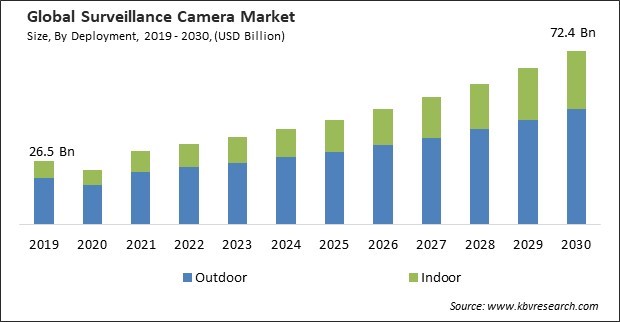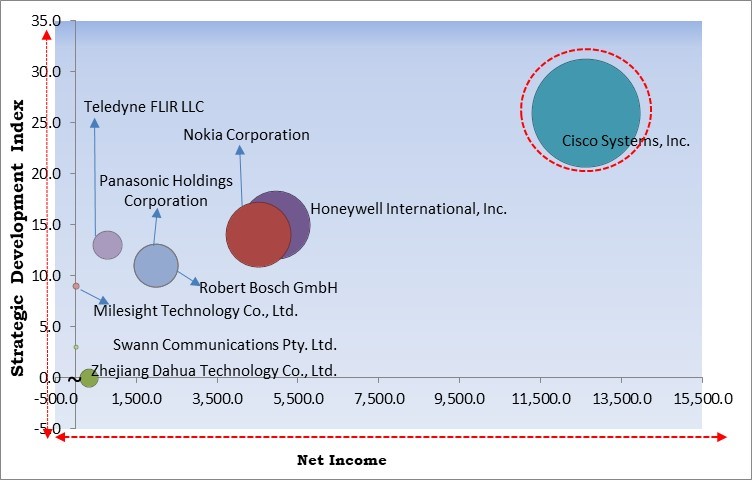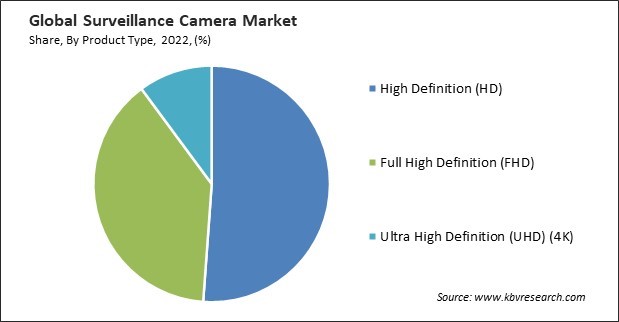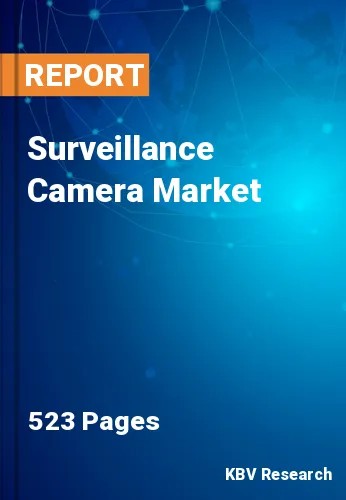The Global Surveillance Camera Market size is expected to reach $72.4 billion by 2030, rising at a market growth of 10.2% CAGR during the forecast period. In the year 2022, the market attained a volume of 755.4 million units, experiencing a growth of 9.6% (2019-2022).
Wi-Fi cameras do not require physical Ethernet cables for data transmission, offering flexibility in camera placement. This makes them ideal for locations where wired connections are challenging or impractical. Thus, the Wi-Fi segment captured $5,669.5 million revenue in the IP-based segment of the market in 2022. Expanding the Wi-Fi surveillance system is relatively straightforward. Additional cameras can be added to the existing network without significant infrastructure changes. Installing Wi-Fi cameras is generally simpler and faster than running Ethernet cables. This reduces installation time and associated costs.

The major strategies followed by the market participants are Product Launches as the key developmental strategy to keep pace with the changing demands of end users. For instance, in October, 2023, Nokia Corporation announced the launch of Autonomous Inventory Monitoring Service (AIMS. The drones within the suite are navigable throughout the warehouse and provide an excellent ROI of up to 40 percent. Additionally, In August, 2023, Teledyne FLIR LLC unveiled Lepton 3.1R, a radiometric thermal camera module. The module has a 95-degree field of view and a maximum scene dynamic range of 400 degrees Celsius.
Based on the Analysis presented in the KBV Cardinal matrix; Cisco Systems, Inc. is the forerunner in the market. Companies such as Honeywell International, Inc., Nokia Corporation, Panasonic Holdings Corporation are some of the key innovators in market. In July, 2019, Honeywell International, Inc. released 30 Series IP Cameras, a series of building security cameras. The features of the cameras include Secure channel encryption, used for facilitating encrypted streaming to Honeywell MAXPRO Network Video Recorders (NVR), Advanced motion people detection, used for accurate detection of human movement, and Enhanced image quality up to 5 MP.

Increasing concerns about safety and security have ushered in a host of positive developments within the market. This heightened awareness of security challenges has substantially expanded the market's reach and influence, bringing forth a cascade of benefits for various stakeholders. The surge in safety and security concerns has broadened the application of surveillance cameras and sparked significant technological innovation. As safety and security remain paramount in an increasingly complex and interconnected world, the positive impact of these concerns on the market is poised to continue, with further innovations and applications on the horizon.
AI-powered analytics plays an increasingly central role in predictive security. AI-driven predictive security solutions require cameras with advanced capabilities, such as real-time video analysis and object recognition. As a result, businesses and organizations have shown a heightened interest in upgrading their existing surveillance infrastructure or investing in new, AI-ready cameras. This growing demand has spurred manufacturers to develop and offer a broader range of AI-powered surveillance cameras tailored to specific industries and use cases. As AI technology continues to evolve, their relationship with AI-driven predictive security is likely to further shape the future of security and surveillance across the globe.
Enhanced privacy and ethical considerations surrounding surveillance cameras have become increasingly important in recent years as these devices have proliferated in various public and private settings. These concerns reflect society's growing awareness of the potential impact on individual privacy and the need for responsible and ethical use of surveillance technology. One significant aspect of enhanced privacy considerations is the protection of individual rights and personal data. As surveillance becomes more pervasive, there will be heightened attention to privacy and ethical concerns, which may deter the expansion of the market.
On the basis of deployment, the market is classified into indoor and outdoor. The indoor segment acquired a substantial revenue share in the market in 2022. Indoor surveillance cameras are primarily deployed to protect the interior of buildings, homes, or facilities. They are highly effective at monitoring entry points, common areas, and sensitive areas such as offices, warehouses, or retail spaces. In incidents or disputes, indoor cameras provide critical video evidence. This evidence can aid in resolving conflicts, investigations, and legal matters. Indoor surveillance can operate around the clock, providing continuous monitoring and recording even when the premises are vacant.
Based on product type, the market is characterized into IP-based, analog camera, and cellular camera. The IP-based segment garnered the highest revenue share in the market in 2022. IP cameras typically offer high-definition (HD) or even 4K video quality. This clarity is crucial for identifying individuals or objects in surveillance footage. These cameras can be accessed remotely over the Internet. Users can view live streams and recorded footage from their smartphones, tablets, or computers, providing flexibility and convenience for monitoring. IP cameras can be remotely accessed via the Internet.

The IP-based segment is further divided into Wi-Fi and wired. The wired segment recorded the largest revenue share in the market in 2022. Wired surveillance systems are known for their reliability. They guarantee consistent performance because they are less vulnerable to interference and signal loss than wireless systems. Wired cameras are appropriate for critical applications and high-security settings because wired connections are more reliable than wireless ones. Wired connections provide consistent and dedicated bandwidth for them, ensuring reliable and uninterrupted video feeds.
By resolution capacity, the market is divided into high definition (HD), full high definition (FHD), and ultra-high definition (UHD)(4K). The ultra-high definition (UHD/4K) segment witnessed a considerable growth rate in the market in 2022. UHD cameras can cover extensive areas with fewer cameras, reducing installation and maintenance costs. This makes them ideal for large-scale surveillance projects. UHD cameras enhance situational awareness by providing detailed images and enabling precise tracking of people and objects. This is valuable for critical applications like airport security and perimeter monitoring.
Based on end-use, the market is segmented into residential, commercial infrastructure, public facilities, industrial, military & defense, and others. The commercial infrastructure segment garnered the maximum revenue share in the market in 2022. The segment's expansion can be attributed to the increasing use of these to monitor public areas like corporate offices, retail stores, shopping malls, and other commercial buildings. Surveillance cameras in the aforementioned commercial spaces provide a potent deterrent to vandalism, unauthorized access, and theft, ensuring the security of the assets, clients, and staff.
| Report Attribute | Details |
|---|---|
| Market size value in 2022 | USD 33.6 Billion |
| Market size forecast in 2030 | USD 72.4 Billion |
| Base Year | 2022 |
| Historical Period | 2019 to 2021 |
| Forecast Period | 2023 to 2030 |
| Revenue Growth Rate | CAGR of 10.2% from 2023 to 2030 |
| Number of Pages | 523 |
| Number of Table | 1073 |
| Quantitative Data | Volume in Million Units, Revenue in USD Billion, and CAGR from 2019 to 2030 |
| Report coverage | Market Trends, Revenue Estimation and Forecast, Segmentation Analysis, Regional and Country Breakdown, Competitive Landscape, Companies Strategic Developments, Company Profiling |
| Segments covered | Product Type, Deployment, Resolution Capacity, End-use, Region |
| Country scope | US, Canada, Mexico, Germany, UK, France, Russia, Spain, Italy, China, Japan, India, South Korea, Singapore, Malaysia, Brazil, Argentina, UAE, Saudi Arabia, South Africa, Nigeria |
| Growth Drivers |
|
| Restraints |
|
Region-wise, the market is analysed across North America, Europe, Asia Pacific, and LAMEA. The Asia Pacific segment recorded the highest revenue share in the market in 2022. This region's numerous investing nations are promoting surveillance systems for traffic management, urban planning, and public safety. Integrating surveillance equipment with Internet of Things (IoT) technology and cloud-based solutions is becoming increasingly popular in the market. In order to meet the changing needs of businesses and governmental organizations, this enables improved data storage, remote access, and scalability.
Free Valuable Insights: The Global Surveillance Camera Market size to reach USD 72.4 Billion by 2030
The market research report covers the analysis of key stake holders of the market. Key companies profiled in the report include Eye Trax, Inc, Milesight Technology Co., Ltd., Swann Communications Pty. Ltd. (Infinova Corporation), Honeywell International, Inc., Cisco Systems, Inc., Nokia Corporation, Panasonic Holdings Corporation, Robert Bosch GmbH, Teledyne FLIR LLC (Teledyne Technologies Incorporated), and Zhejiang Dahua Technology Co., Ltd.
By Deployment (Volume, Million Units, USD Billion, 2019 to 2030)
By Product Type (Volume, Million Units, USD Billion, 2019 to 2030)
By Resolution Capacity (Volume, Million Units, USD Billion, 2019 to 2030)
By End-use (Volume, Million Units, USD Billion, 2019 to 2030)
By Geography (Volume, Million Units, USD Billion, 2019 to 2030)
This Market size is expected to reach $72.4 billion by 2030.
Increasing Concerns about Safety and Security are driving the Market in coming years, however, Enhanced Privacy and Ethical Concerns restraints the growth of the Market.
Eye Trax, Inc, Milesight Technology Co., Ltd., Swann Communications Pty. Ltd. (Infinova Corporation), Honeywell International, Inc., Cisco Systems, Inc., Nokia Corporation, Panasonic Holdings Corporation, Robert Bosch GmbH, Teledyne FLIR LLC (Teledyne Technologies Incorporated), and Zhejiang Dahua Technology Co., Ltd.
In the year 2022, the market attained a volume of 755.4 million units, experiencing a growth of 9.6% (2019-2022).
The Outdoor segment is capturing maximum revenue in the Market by Deployment in 2022; thereby, achieving a market value of $48.1 billion by 2030.
The Asia Pacific region is generating the highest revenue in the Market by Region in 2022, and would continue to be a dominant market till 2030; thereby, achieving a market value of $33.7 billion by 2030.
Our team of dedicated experts can provide you with attractive expansion opportunities for your business.

